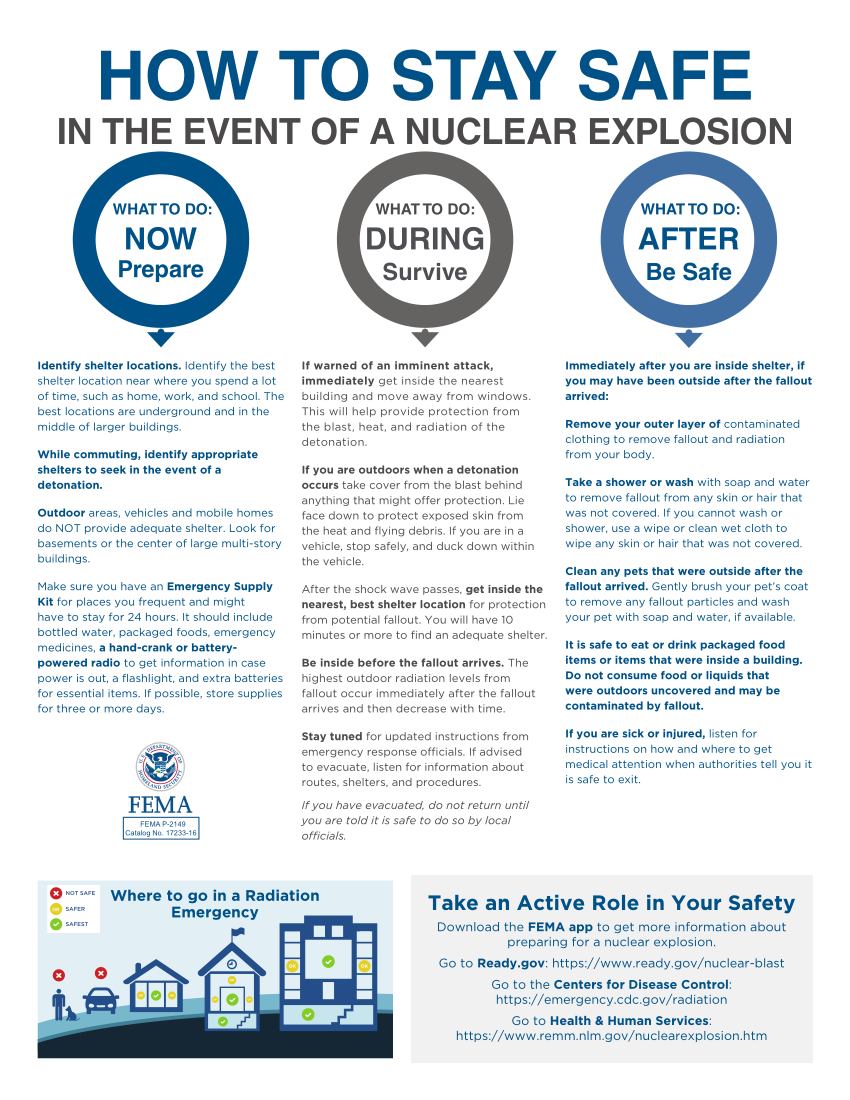Nuclear/Radiological Incident
THE POINT
DO THIS
Learn and teach others what to do in the event of a nuclear or radiological event.
Ask your city how they plan to communicate with the public.
Protective Action: Get Inside, Stay Inside, Stay Tuned
VIDEOS
- Where to Go in a Radiation Emergency
- How to Protect Yourself After a Nuclear Explosion
- Self-Decontamination - Protective Actions for Radiation Emergencies
- Get Inside, Stay Inside, Stay Tuned - Protective Actions for Radiation Emergencies
- Can you survive nuclear fallout? (Ted-Ed)
- Food and Water Safety - Protective Actions for Radiation Emergencies
- Webinar - Are You Rad-Savvy? Applying Communication for a Nuclear or Radiological Disaster
- KI (Potassium Iodide) - Pharmaceutical Treatment for Radiation Emergencies
- Prussian Blue - Pharmaceutical Treatment for Radiation Emergencies
- Intro- Myths of Radiation
- Myth 1 - Myths of Radiation
- Myth 2 - Myths of Radiation
- Myth 3 - Myths of Radiation
- Myth 4 - Myths of Radiation
- Myth 5 - Myths of Radiation
- Myth 6 - Myths of Radiation
- Myth 7 - Myths of Radiation
DOWNLOADS
- CDC - Nuclear Infographic
- FEMA Fact Sheet - Be Prepared for a Nuclear Explosion
- Where to Go in a Radiation Emergency
- Decontamination for Yourself and Others
- Radiation Emergencies and Pregnancy
- Food, Drinking Water and Medicine: Nuclear Detonation Safety
- Protective Action Questions & Answers for Radiological and Nuclear Emergencies
LINKS
- Ready.gov/nuclear-explosion
- Ready.gov/nuclear-power-plants
- Ready.gov/radiological-dispersion-device
- CDC - Radiation Emergencies
- CDC - Medical Treatments for Radiation Exposure and Contamination
- Reducing Nuclear Risk and Enhancing Global Nuclear Security - NTI
- Public Communication Resources for Nuclear and Radiological Preparedness - EPA
Exercise
- This is a TEST: Game / Table-top exercise for radiation incident (CDC)
Nuclear and Radiological Incidents
The three factors for protecting oneself from radiation and fallout are distance, shielding, and time.
- Distance — the more distance between you and the fallout particles, the better. An underground area such as a home or office building basement offers more protection than the first floor of a building. A floor near the middle of high-rise may be better, depending on what is nearby at that level on which significant fallout particles would collect. Flat roofs collect fallout particles so the top floor is not a good choice, nor is a floor adjacent to a neighboring flat roof.
- Shielding — the heavier and denser the materials—thick walls, concrete, bricks, books and earth—between you and the fallout particles, the better.
- Time — fallout radiation loses its intensity fairly rapidly. In time, you will be able to leave the fallout shelter. Radioactive fallout poses the greatest threat to people during the first two weeks, by which time it has declined to about 1 percent of its initial radiation level.
Remember that any protection, however temporary, is better than none at all, and the more shielding, distance, and time you can take advantage of, the better.
Protective Action

Prepare
To prepare for a nuclear blast, you should do the following:
- Find out from officials if any public buildings in your community have been designated as fallout shelters. If none have been designated, make your own list of potential shelters near your home, workplace, and school. These places would include basements or the windowless center area of middle floors in high-rise buildings, as well as subways and tunnels.
- If you live in an apartment building or high-rise, talk to the manager about the safest place in the building for sheltering and about providing for building occupants until it is safe to go out.
- During periods of increased threat, increase your disaster supplies to be adequate for up to two weeks.
What to do in the event of a nuclear explosion
Taking shelter during a nuclear blast is absolutely necessary. There are two kinds of shelters—blast and fallout. The following describes the two kinds of shelters:
- Blast shelters are specifically constructed to offer some protection against blast pressure, initial radiation, heat, and fi re. But even a blast shelter cannot withstand a direct hit from a nuclear explosion.
- Fallout shelters do not need to be specially constructed for protecting against fallout. They can be any protected space, provided that the walls and roof are thick and dense enough to absorb the radiation given off by fallout particles.
If an attack warning is issued:
- Take cover as quickly as you can, below ground if possible, and stay there until instructed to do otherwise.
- Listen for official information and follow instructions.
If you are caught outside and unable to get inside immediately:
- Do not look at the flash or fireball—it can blind you.
- Take cover behind anything that might offer protection.
- Lie flat on the ground and cover your head. If the explosion is some distance away, it could take 30 seconds or more for the blast wave to hit.
- Take shelter as soon as you can, even if you are many miles from ground zero where the attack occurred—radioactive fallout can be carried by the winds for hundreds of miles. Remember the three protective factors: Distance, shielding, and time.
Returning to Your Home
Remember the following:
- Keep listening to the radio and television for news about what to do, where to go, and places to avoid.
- Stay away from damaged areas. Stay away from areas marked “radiation hazard” or “HAZMAT.” Remember that radiation cannot be seen, smelled, or otherwise detected by human senses.


